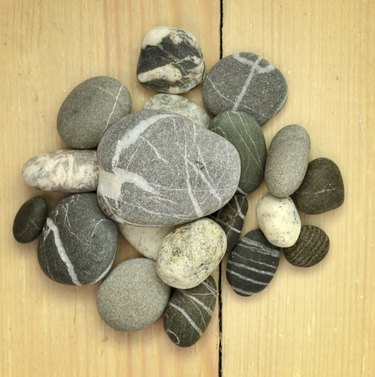Things You'll Need
Damp cloth
Paper towels
Fine-grit sandpaper
Polyurethane construction adhesive or jewelry adhesive
Cotton swabs or flat-sided toothpicks

Working with materials so different from each other such as stone and wood causes a bit of a conundrum when you're trying to choose a suitable glue. Glues for porous materials like wood may not stick to non-porous substances, and vice versa. Finding a glue that sticks to both substances requires reading product labels carefully to ensure the adhesive is designed for both materials -- using the wrong type of glue may result in a project that falls apart or never sticks together in the first place, ruining the project materials in the process with globs of dried glue. Construction adhesives designed for many surfaces hold glue and stone together.
Step 1
Wipe the bottom side of the stones with a damp cloth to remove any dust or dirt. Wipe them dry with a paper towel and allow the stones to air dry completely.
Video of the Day
Step 2
Scuff the wood gently with a piece of fine-grit sandpaper on the area to which you intend to glue. Wipe the dust away with a paper towel. Scuffing helps the adhesive stick better and can be done over varnished or painted wood as well.
Step 3
Cover the work surface with newspaper to catch stray drops of glue. Place the wood and stones atop the paper.
Step 4
Squirt construction adhesive on the bottom of each stone, pressing it into the desired location on the wood, if working with large- or medium-sized stones. For a small project, such as a wooden pill box with tiny gemstones, use a jewelry adhesive designed to work on both wood and stone. Apply adhesive to small stones with a cotton swab or a flat-sided toothpick. If the adhesive packaging recommends that you do so, apply the adhesive to both objects, wait a minute or the recommended length of time, then press the pieces together. Allow the glue to dry for several hours or as recommended on the package before handling the project.
Tip
Choose stones that are completely flat on the bottom side for best results. In the same manner, stones stick better to a flat wood surface than to rough-textured wood such as bark on a branch.
An epoxy or jewelry adhesive designed to work with wood and stone may be used in place of a construction adhesive. Work only in a well-ventilated area if using such adhesives to avoid breathing in strong fumes. Ideally, choose an adhesive that has low-VOC (volatile organic compound) content for minimal odor.
Warning
If you plan to use your project outdoors or in a damp or wet environment, choose a waterproof adhesive designed for both wood and stone. Many polyurethane and polyvinyl acetate (PVA) adhesives are not designed to hold up to wet conditions; the packaging will state the specifics.
Video of the Day